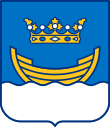
Kyösti Kallio was a Finnish politician who served as the fourth president of Finland from 1937 to 1940. His presidency included leading the country through the Winter War; while he relinquished the post of commander-in-chief to Carl Gustaf Emil Mannerheim, he played a role as a spiritual leader. After the war, he became both the first President of Finland to resign and the only one to die in office, dying of a heart attack while returning home after submitting his resignation.
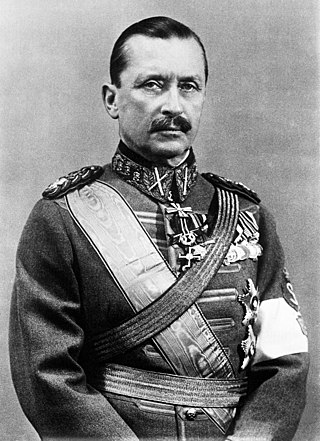
Carl Gustaf Emil Mannerheim was a Finnish military commander, aristocrat, and statesman. He served as the military leader of the Whites in the Finnish Civil War (1918), as Regent of Finland (1918–1919), as commander-in-chief of the Finnish Defence Forces during the period of World War II (1939–1945), and as the sixth president of Finland (1944–1946). He became Finland's only field marshal in 1933 and was appointed honorary Marshal of Finland in 1942.

Nils Adolf Erik Nordenskiöld was a Finland-Swedish aristocrat, geologist, mineralogist and Arctic explorer. He was a member of the noble Nordenskiöld family of scientists and held the title of a friherre (baron).
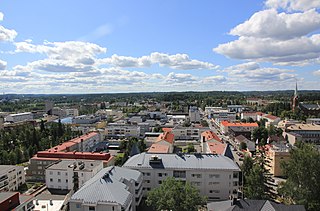
Mikkeli is a city in Finland and the regional capital of South Savo. It is located in the Finnish Lakeland. The population of Mikkeli is approximately 52,000, while the sub-region has a population of approximately 68,000. It is the 18th most populous municipality in Finland, and the 19th most populous urban area in the country.

Kiasma is a contemporary art museum located on Mannerheimintie in Helsinki, Finland. Its name kiasma, Finnish for chiasma, alludes to the basic conceptual idea of its architect, Steven Holl. Kiasma is part of the Finnish National Gallery, and it is responsible for the gallery's contemporary art collection. Its central goal is to showcase contemporary art and to strengthen its status.
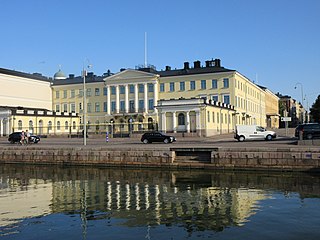
The Presidential Palace is one of the three official residences of the president of the Republic of Finland. It is situated in Helsinki, on the north side of Esplanadi, overlooking Market Square.

The Order of the Cross of Liberty is one of three official state orders in Finland, along with the Order of the White Rose of Finland and the Order of the Lion of Finland.

The Order of the Lion of Finland is one of three official orders in Finland, along with the Order of the Cross of Liberty and the Order of the White Rose of Finland. The President of Finland is the Grand Master of all three orders. The orders are administered by boards consisting of a chancellor, a vice-chancellor and at least four members. The orders of the White Rose of Finland and the Lion of Finland have a joint board. The President of Finland wears the Star of the Order of the Lion of Finland.

Mannerheimintie, named after the Finnish military leader and statesman Carl Gustaf Emil Mannerheim, is the main street and boulevard of Helsinki, Finland. It was originally named Heikinkatu, after Robert Henrik Rehbinder on the first part up to the current Kiasma Art museum and Turuntie after that, but was renamed after the Winter War. The change of name was also a reference to Mannerheim's victory parade along the road during the Finnish Civil War (1918), after German forces, allied with Mannerheim's Finnish forces, had retaken the city.

Count Carl Gustaf Mannerheim was a Finnish nobleman, amateur entomologist and governor of the Viipuri province in the Grand Duchy of Finland. He collected beetles from across the Arctic region from Alaska to Russia through northern Scandinavia making use of a network of aristocratic amateurs and Finnish settlers resulting in a personal collection of nearly 100000 specimens of beetles representing 20,000 species made over a period of 40 years.

Tamminiemi is a villa and house museum located in the Meilahti district of Helsinki, Finland. It was one of the three official residences of the President of Finland, from 1940 to 1982. From 1956, until his death in 1986, it served as the residence of President Urho Kekkonen. Since 1987, it has been the Urho Kekkonen Museum. Tamminiemi is located in a park by the sea. Its floor area is about 450 square metres (4,800 sq ft); living quarters comprise the first two floors while the third floor is dedicated to office space.

Johannes Ferdinand "Hannes" Ignatius was a Finnish soldier and a prominent advocate for Finnish independence.

The Military Museum of Finland is the central museum of the Finnish Defence Forces and the national special museum of military history. It is located in Helsinki and it is part of the Finnish National Defence University. In 2018, the Military Museum's exhibitions in Suomenlinna had around 131,000 visitors. The most popular exhibition is the submarine Vesikko, visited by around 50,000 people annually. Military Museum's exhibitions in Suomenlinna are located at Manege and Artillery Maneage.

The Artillery Museum of Finland is a special military museum dedicated to the history of the artillery from the 15th century to the present day. It was located in Niinisalo from 1977 to 1997. In 1997 it was relocated to Hämeenlinna.

Defence Command, organized as Headquarters during wartime, is the joint command headquarters of the Finnish Defence Forces and a central government agency. Active since 1918, it leads and monitors the execution of the duties prescribed to the Defence Forces, such as the military defence of Finland.

A bronze equestrian statue of Field Marshal Gustaf Mannerheim stands in the centre of Helsinki, Finland. It was made by Aimo Tukiainen and erected in 1960.

Louhisaari Manor is a historic baroque manor house in Askainen in the municipality of Masku, Western Finland Province, Finland. The mansion is the birthplace and childhood home of Carl Gustaf Emil Mannerheim, Finnish military leader, statesman and sixth president of Finland (1944–1946).
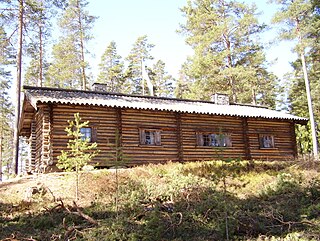
The Marshal's Cabin is a current museum and restaurant at the shores of Lake Punelia in Loppi, Finland, near the Räyskälä village. Originally, the cabin with its courtyards was built as a 14th division birthday present for Marshal C. G. E. Mannerheim in 1942 and was originally located in Rugozero, East Karelia. It also includes a log-built summer house, a banqueting hall and a sauna.
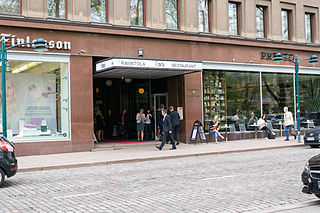
Savoy is a restaurant in Helsinki, Finland, located on the Eteläesplanadi street. The restaurant opened on 3 June 1937. It is located in a space designed by Finnish architects Aino and Alvar Aalto, and furnished by the company Artek, which they had founded two years earlier. It was renovated in 2019. The Savoy is considered a hallmark of Finnish cuisine.

Vanajanlinna Manor is a historic mansion in Hämeenlinna, Finland. The manor is situated next to Lake Katuma (Katumajärvi). It was designed by Finnish architect Sigurd Frosterus and built in the 1920s by Finnish business magnate Carl Wilhelm Rosenlew. Rosenlew intended the manor to serve as his hunting lodge for the Finnish political and economic elite.





















